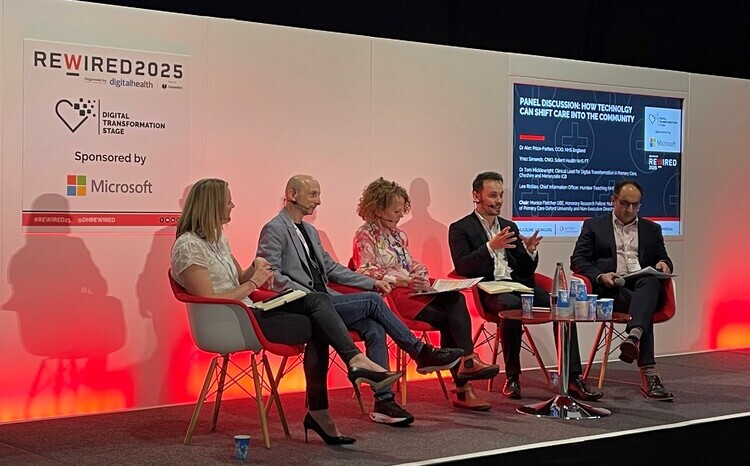Converge around the person, not the technology
- 30 May 2023

The debate on EPR convergence needs to acknowledge the inescapable variety of the health and care landscape, and put people first, writes Alastair Allen
Just over a year ago Tim Ferris announced plans to converge Electronic Patient Records (EPRs) in use across NHS Integrated Care System (ICS) boundaries. Since then, there has been much discussion and debate surrounding what is meant by “convergence” and how an ICS would go about implementing a “managed convergence” strategy.
I believe convergence should be based around the person. There are many ways to deliver the same outcome – just look at the recent KLAS report for example, where there was extreme polarisation between different organisations using the same EPR. It’s not just about the technology. It is also about the adoption and change around it. By designing outcome-based services that are centred around the person we stand a better chance of success.
The EPRs deployed within and across England’s health and care settings are as varied as the settings themselves. For example, in primary care there are a small group of vendors who dominate, which in turn are different to the slightly larger group of vendors who are mainly deployed across the acutes. Care provider organisations have historically had the freedom to procure their own systems, which has led to a diverse mix – both within and across different care settings.
Systems don’t talk to one another
This results in a model where information capture and sharing between professionals is sub-optimal, leading to potential patient safety risks, increased costs of duplicate systems and duplicate data, and negative impacts on staff who must use multiple different systems.
It is a significant problem for both professionals and service users, especially where the patient pathway has touch points across more than one care setting or indeed across more than one care provider organisation.
Given the debacle of the National Programme for IT (NPfIT) there was never going to be any attempt to converge around a national EPR, so the idea of converging at a regional level makes a lot of sense.
However, the problem convergence needs to solve is likely to vary across different parts of the country. In heavily urban areas like London a lot of people will present across the capital and across ICS boundaries, but in rural geographies there may be less breadth of interaction. Furthermore, some areas facing economic challenge may need to buy more for less. In other areas the population demographic may present a pathway challenge where there is a significant engagement across health and social care settings.
In his letter, Ferris outlined how: “Our primary focus is to achieve universal EPR coverage across all ICSs (i.e.to level up EPR provision)”. He went on to say: “We are also encouraging ICSs to work towards the managed convergence of EPRs over time, to reduce the number of EPRs across acute care, community services, mental health, ambulance services, primary care, and social care”.
Levelling up EPR provision is of course a good thing. Around 20% of NHS Trusts today have no EPR, while approximately 60% are going through a process to meet the core level of digitisation. So, supporting these trusts in “levelling up” is a fantastic initiative.
Converging EPRs over time to consolidate the footprint within individual care settings makes sense. This could help rationalise spending, optimise rollout, and reduce the overall number of siloed applications.
But the idea that in doing so we will deliver the benefits of “real-time access to all health related information” or “simplified access for patients”, as Ferris also suggested, is hugely unrealistic.
There are several reasons for this, including:
- The patient pathway will often span multiple care settings. So, even if an ICS does converge all EPRs across acute care, this does not solve a problem for professionals working in primary care, community services, mental health and social care – not to mention the private sector.
- Most ICSs in a region are at very different levels of maturity and rollout. Where individual ICSs have EPRs from different vendors successfully deployed can the cost of consolidating into a single EPR really be justified?
- A single EPR will never cover all the data within an organisation. Even the biggest adopters of the “mega-suite” EPRs still have an eco-system of other applications and services.
- As outlined by the NHS Service Manual people should be at the heart of everything you do and services should be designed for the outcome. In my experience, projects that don’t do this typically fail.
Furthermore, the idea that convergence is aligned to individual vendors introduces a whole new set of risks. For example, all vendors have their own roadmaps. Innovative health systems cannot rely on vendors to deliver what they need. Given the diversity of the NHS there are unique needs that will need tailored solutions to address.
A realistic goal
In practical terms, a realistic goal is to achieve some consolidation of EPRs within each of the various care settings. But to solve the problem and deliver the outcome we must go further. Some would argue that the solution is to converge around current healthcare standards then. That’s the point of interoperability, right?
Unfortunately, the NHS (and most other global healthcare systems) have struggled, for years, to make computer systems exchange and make use of information through the adoption of different healthcare standards, including HL7 v2, v3, CDA and most recently various iterations of FHIR. This approach typically involves standardisation at a technical (or syntactic) level, with the clinical content (or semantics) being mapped or translated when sent between systems.
Adoption of these standards is still required and will be an important part of the overall landscape, but unless we agree upon and adopt at a semantic level then stitching together an entire ICS in this manner will not scale.
Shared Care Records deliver a huge number of benefits, but they are typically a read-only view of what has happened to the patient up to a point in time. To deliver the benefits outlined above and to support regional transformation, an architecture is required that will allow service users and professionals from all care settings to have (governed and secure) real-time read and write access to data.
There is only one way to solve this across an entire ICS.
Converge around person-centred data
By converging around person-centred data, we will see individual applications being separated from the data and move towards the development of a single longitudinal record for an individual, one that is integrated into the existing application landscape. This approach allows data to follow the person – wherever they may be – and not to be stuck inside individual provider systems. In doing so, you provide the foundation for different regions to transform in a way that is appropriate for them.
Key to this approach is a commonly agreed set of information models that are adopted consistently across all ICSs. If adopting a standard such as openEHR there are a rich library of mature models already available that could support this. This of course is only part of the answer and would need to sit alongside an empowered group of clinical informaticians who would implement and govern the process around these models.
As outlined in the EY Connected Health Cloud paper, these repositories can sit alongside existing proprietary data stores or as fully independent data stores that natively use the adopted information models.
To ensure early and incremental delivery the entire process should be based around pathway-based use cases. This would ensure ICSs don’t get overwhelmed with trying to get all their data in order in one go. OneLondon is a good example, where they adopted a similar approach and went live with their first pathway in only seven months.
Managed convergence at an ICS level will require a hybrid approach. Simply rolling out an EPR from an individual vendor may be part of the answer but it is not enough. Adopting a longitudinal data layer that is centred around the person will allow data to flow more easily in support of pathways that span multiple organisations and care settings.
We should consolidate EPRs within care settings, comply with standards, and, above all, converge around the person.





